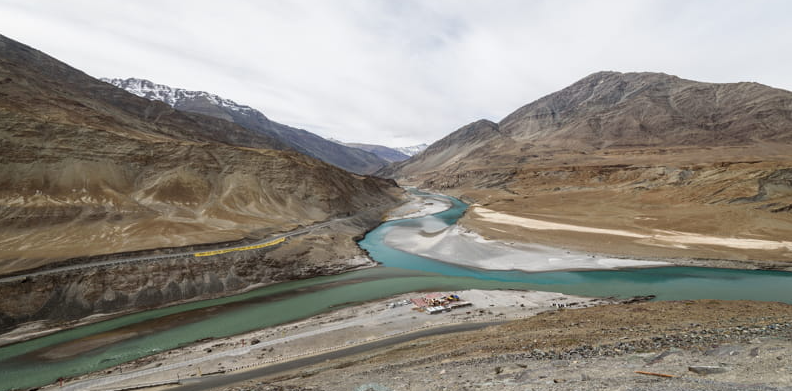Indus Water Treaty (GS Paper 2, IR)

Introduction
- The Indus Waters Treaty (IWT) is a critical agreement between India and Pakistan, signed on September 19, 1960, and brokered by the World Bank.
- This treaty has governed the water-sharing of the Indus River and its tributaries for over six decades, standing as a significant example of cooperation between the two neighboring countries.
- Recently, the treaty was back in the spotlight as a five-member Pakistani delegation visited Jammu’s Kishtwar to inspect power projects set up on the rivers covered under the IWT.
What is the Indus Water Treaty (IWT)?
About
- The Indus Waters Treaty was established to manage the use and distribution of the waters of the Indus River and its five tributaries—Sutlej, Beas, Ravi, Jhelum, and Chenab—between India and Pakistan.
- The treaty outlines mechanisms for cooperation and information exchange and sets a framework for resolving disputes related to water-sharing.
Key Provisions
Water Sharing
The treaty specifies how the water from the six rivers of the Indus River System is shared:
- The three western rivers—Indus, Chenab, and Jhelum—are allocated to Pakistan for unrestricted use. India can use these waters for certain non-consumptive purposes, including agriculture and domestic needs.
- The three eastern rivers—Ravi, Beas, and Sutlej—are allocated to India for unrestricted use.
- This allocation means that Pakistan receives about 80% of the water, while India uses the remaining 20%.
Permanent Indus Commission
- The treaty mandates the establishment of a Permanent Indus Commission, which is required to meet annually to facilitate cooperation and resolve issues.
Dispute Resolution Mechanism
The IWT includes a three-step dispute resolution mechanism:
- Questions on both sides can be resolved at the Permanent Commission level.
- Unresolved issues can be escalated to the inter-government level.
- Further disputes can be addressed by a Neutral Expert appointed by the World Bank, and appeals can be referred to a Court of Arbitration set up by the World Bank.
Recent Inspections Under IWT
The Pakistani delegation inspected several hydroelectric projects in Jammu and Kashmir:
- Pakal Dul Hydro Electric Project: Built on the Marusudar River, a tributary of the Chenab.
- Lower Kalnai Hydro Electric Project: Developed on the Chenab River.
- Kishanganga Hydroelectric Project: A run-of-the-river project on the Kishanganga River (Neelum River in Pakistan). Pakistan objected to this project, but in 2013, The Hague’s Permanent Court of Arbitration allowed India to divert water under specific conditions.
- Ratle Hydroelectric Project: Another run-of-the-river project on the Chenab River.
Indus River and Its Tributaries
Source
- The Indus River, known as Sengge Chu or ‘Lion River’ in Tibetan, originates near Mansarovar Lake in the Trans-Himalaya in Tibet.
- It flows through Tibet, India, and Pakistan, providing water to about 200 million people living in its drainage basin.
Course and Major Tributaries
- The Indus River enters India through Ladakh, flows through Jammu and Kashmir, and then reaches Pakistan's Gilgit-Baltistan region. It eventually empties into the Arabian Sea near Karachi.
- Left-bank tributaries: Zaskar, Suru, Soan, Jhelum, Chenab, Ravi, Beas, Satluj, and Panjnad rivers.
- Right-bank tributaries: Shyok, Gilgit, Hunza, Swat, Kunnar, Kurram, Gomal, and Kabul rivers.
Way Forward
To ensure the continued success and effectiveness of the Indus Waters Treaty, both India and Pakistan need to focus on the following areas:
- Technical Dispute Resolution: Utilize the existing framework of the treaty to resolve technical disputes efficiently.
- Transparency and Data Sharing: Enhance mutual trust by sharing hydrological data and addressing shared concerns.
- Joint Basin Management: Collaborate on managing the Indus basin to tackle challenges posed by climate change and population growth, focusing on water conservation, flood control, and sustainable usage.
- Political Commitment and Dialogue: Prioritize dialogue and cooperation over confrontation to find sustainable solutions for both countries.
Conclusion
- The Indus Waters Treaty remains a cornerstone of India-Pakistan relations, symbolizing the potential for cooperation amidst political differences.
- By strengthening the treaty’s implementation and addressing emerging challenges, both nations can continue to benefit from this vital agreement.


